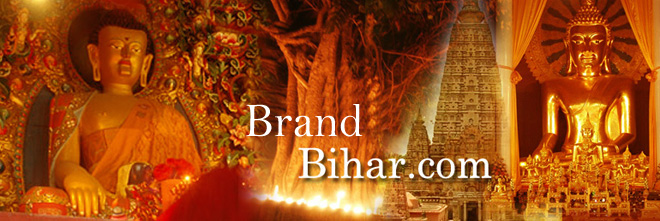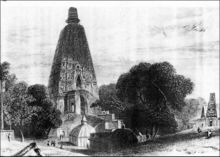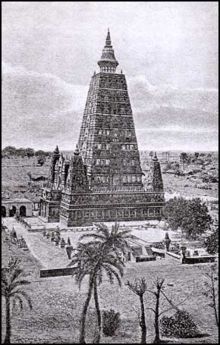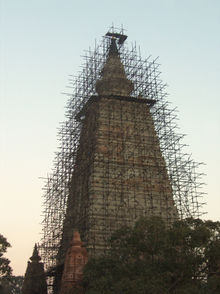|
|
Mahabodhi Temple
The Mahabodhi Temple (Literally: "Great Awakening Temple") is a Buddhist temple in Bodh Gaya, the location where Siddhartha Gautama, the Buddha, attained enlightenment. Bodh Gaya is located about 96 km (60 miles) from Patna, Bihar state, India. Next to the temple, to its western side, is the holy Bodhi tree. In the Pali Canon, the site is called Bodhimanda, and the monastery there the Bodhimanda Vihara.
The temple is located at 24.6959° N, 84.9911° E.
Buddhist legends concerning the site of the Mahabodhi Temple
The site of the Bodhi tree at Bodhigaya is, according to the Buddhist commentarial scriptures, the same for all Buddhas. According to the Jatakas, it forms the navel of the earth, and no other place can support the weight of the Buddha's attainment.
When no Bodhi tree grows at the site, the Bodhimanda (ground round the Bodhi-tree), for a distance of one royal karīsa, is devoid of all plants, even of any blade of grass, and is quite smooth, spread with sand like a silver plate, while all around it are grass, creepers and trees. None can travel in the air immediately above it, not even Sakka.
In the case of Gautama Buddha, his Bodhi tree sprang up on the day he was born.

Rise of Buddhism
Traditional accounts say that, around 530 BC, Gautama Buddha, wandering as a monk, reached the sylvan banks of Falgu River, near the city of Gaya, India. There he sat in meditation under a peepul tree (Ficus religiosa or Sacred Fig), which later became known as the Bodhi tree. According to Buddhist scriptures, after three days and three nights, Siddharta attained enlightenment and the answers that he had sought. Mahabodhi Temple was built to mark that location.
The Buddha then spent the succeeding seven weeks at seven different spots in the vicinity meditating and considering his experience. Several specific places at the current Mahabodhi Temple relate to the traditions surrounding these seven weeks:
The first week was spent under the Bodhi tree.
During the second week, the Buddha remained standing and stared, uninterrupted, at the Bodhi tree. This spot is marked by the Animeshlocha Stupa, that is, the unblinking stupa or shrine, which is located on the north-east of the Mahabodhi Temple complex. There stands a statute of Buddha with his eyes fixed towards the Bodhi tree.
The Buddha is said to have walked back and forth between the location of the Animeshlocha Stupa and the Bodhi tree. According to legend, lotus flowers sprung up along this route, it is now called Ratnachakarma or the jewel walk.
Construction
In approximately 250 BC, about 250 years after the Buddha attained Enlightenment, Buddhist Emperor Asoka visited Bodh Gaya with the intention of establishing a monastery and shrine. As part of the temple he built, the diamond throne (called the Vajrasana), attempting to mark the exact spot of the Buddha's enlightenment, was established. Asoka is considered the founder of the Mahabodhi Temple.
Decline
Buddhism declined when the dynasties patronizing it declined, following White Hun and the early Islamic invasions such as that of Muhammad bin Qasim. A strong revival occurred under the Pala Empire in the northeast of the subcontinent (where the temple is situated). Mahayana Buddhism flourished under the Palas between the 8th and the 12th century. However, after the defeat of the Palas by the Hindu Sena dynasty, Buddhism's position again began to erode and became nearly extinct in India. During the 12th century AD, Bodh Gaya and the nearby regions were invaded by Muslim armies. During this period, the Mahabodhi Temple fell into disrepair and was largely abandoned. During the 16th century, a Hindu monastery was established near Bodh Gaya. Over the following centuries, the monastery's abbot or mahant became the area's primary landholder and claimed ownership of the Mahabodhi Temple grounds.
Restoration
 The temple as it appeared in the 1780s.
In the 1880s, the-then British government of India began to restore Mahabodhi Temple under the direction of Sir Alexander Cunningham. A short time later, in 1891, the Sri Lankan Buddhist leader Anagarika Dharmapala started a campaign to return control of the temple to Buddhists, over the objections of the mahant. The campaign was partially successful in 1949, when control passed from the Hindu mahant to the state government of Bihar, which established a temple management committee. The committee has nine members, a majority of whom, including the chairman, must by law be Hindus. Mahabodhi's first head monk under the management committee was Anagarika Munindra, a Bengali man who had been an active member of the Maha Bodhi Society. The temple as it appeared in the 1780s.
In the 1880s, the-then British government of India began to restore Mahabodhi Temple under the direction of Sir Alexander Cunningham. A short time later, in 1891, the Sri Lankan Buddhist leader Anagarika Dharmapala started a campaign to return control of the temple to Buddhists, over the objections of the mahant. The campaign was partially successful in 1949, when control passed from the Hindu mahant to the state government of Bihar, which established a temple management committee. The committee has nine members, a majority of whom, including the chairman, must by law be Hindus. Mahabodhi's first head monk under the management committee was Anagarika Munindra, a Bengali man who had been an active member of the Maha Bodhi Society.
Architectural style

The temple as it appeared immediately after its restoration
Mahabodhi Temple is constructed of brick and is one of the oldest brick structures to have survived in eastern India. It considered to a fine example of Indian brickwork, and was highly influential in the development of later architectural traditions. According UNESCO, “the present temple is one of the earliest and most imposing structures built entirely in brick from the late Gupta period”.
Mahabodhi Temple's central tower rise to 55 meters, and were heavily renovated in the 19th century. The central tower is surrounded by four smaller towers, constructed in the same style.
The Mahabodhi Temple is surrounded on all four sides by stone railings, about two metres high. The railings reveal two distinct types, both in style as well as the materials used. The older ones, made of sandstone, date to about 150 BC, and the others, constructed from unpolished coarse granite, are believed to be of the Gupta period (300 CE – 600 CE). The older railings have scenes such as Lakshmi, the Hindu goddess of wealth, being bathed by elephants; and Surya, the Hindu sun god, riding a chariot drawn by four horses. The newer railings have figures of stupas (reliquary shrines) and garudas (eagles). Images of lotus flowers also appear commonly.
Current status

Mahabodhi Temple is claimed as property of state government of Bihar, part of India. Under the terms of the Bodh Gaya Temple Act of 1949, the state government makes itself responsible for the protection, management, and monitoring of temple and its properties. The Act also has provisions for a Temple Management Committee, along with an advisory Board, which consists of the governor of Bihar state and twenty to twenty-five other members, half of them from foreign Buddhist countries.
The Temple Management Committee is the executive body for management of the Mahabodhi Temple and certain adjoining areas. The TMC functions under the supervision, direction, and control of the state government of Bihar.
In June 2002, the Mahabodhi Temple became a UNESCO World Heritage Site, specifically nominated for the international World heritage program.
Back To BuddhaBihar Mennu Page

|
|
|